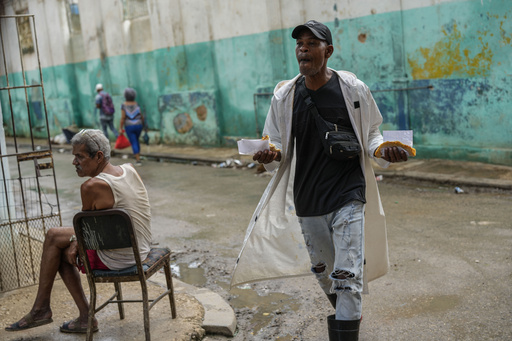
HAVANA — A small town located in the southeastern region of Cuba is beginning the process of recovery following severe flooding that resulted in the loss of at least six lives. This incident occurred as Tropical Storm Oscar swept across the eastern coastline of the island, bringing with it strong winds and significant rainfall.
On Monday night, the capital city faced partial power outages, which spurred protests and prompted a stern warning from the government regarding any disruptions to public order. President Miguel Díaz-Canel, speaking on state television, announced that efforts to rescue and aid the affected residents in San Antonio del Sur are ongoing. Some areas still remain inaccessible for officials due to flooding.
Mayde Quiñones, a homemaker aged 55, expressed the widespread impact of the crisis: “The country has completely halted. This affects everyone, but it is especially painful for the elderly.” Tropical Storm Oscar weakened after making landfall in Cuba as a Category 1 hurricane and was anticipated to deliver up to four inches (10 centimeters) of rainfall across parts of the southeastern Bahamas and the Turks and Caicos Islands.
During a broadcast on Sunday, Díaz-Canel underscored the government’s stance against any acts of vandalism, stating, “We’re not going to allow any disturbance to the peace of our people.” The recent blackout follows a major outage that occurred last Thursday, contributing to the country’s longstanding issues with electricity supply, which were partially responsible for the largest anti-government protests seen in Cuba in nearly three decades back in July 2021.
The ongoing economic crisis has driven over half a million Cubans to migrate to the U.S., with many more making their way to Europe. While the Cuban government places blame on the United States for its long-standing trade embargo, the White House has countered by stating that Cuba’s own management failures are a primary contributor to the hardships faced by its citizens.
Although electricity remains relatively inexpensive, it is increasingly scarce. According to state television reports on Monday evening, the Cuban energy sector is currently generating around 1300 megawatts, while peak demand can soar up to 3 gigawatts. By the afternoon of Monday, around 80 percent of Havana was experiencing intermittent power supply, leading to widespread anxiety among residents.
Juan Estrada, a 53-year-old small-business owner, voiced concerns about keeping food fresh in light of ongoing power issues, stating, “We have the fridge full of food, and we’re scared,” as his business has not enjoyed consistent power since Friday. Energy Minister Vicente de la O Levy expressed hope that power restoration efforts would be completed by Tuesday morning, but announced that classes would be suspended through at least Thursday.
He acknowledged that Storm Oscar would further complicate Cuba’s recovery efforts, noting its potential impact on vital power installations including the Felton plant in Holguín and the Renté facility in Santiago de Cuba.
As a result of the outages, many residents in Havana, home to approximately 2 million people, have resorted to makeshift wood stoves for cooking outside, fearing their perishable food would spoil. Lines have formed at subsidized food outlets, which have been affected by fuel shortages, leading to the closure of numerous gas stations.
The failure of the Antonio Guiteras power plant last Friday has exacerbated an already troubled energy distribution system in a country grappling with electricity shortages due to outdated infrastructure and insufficient maintenance of thermoelectric plants. The recent blackout has been described as the worst since Hurricane Ian struck Cuba as a Category 3 storm in 2022, an event that similarly caused extensive damage to the power grid.
Local officials initially attributed the outage to an increase in demand from small businesses and residential air conditioning units, but it soon worsened due to breakdowns in aged power plants and fuel shortages impacting operations.
